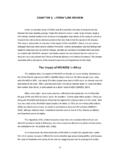Transcription of 40 Neurological disorders: public health …
1 Neurological disorders : public health challenges4041neurologicaldisordersa public health approachCHAPTER 3in this Headache Multiple Neurological disorders associated with Pain associated with Neurological Parkinson s Traumatic brain injuriesThis chapter consists of 10 sections that focus on the public health aspects of the common Neurological disorders as outlined in the box. Although nota-ble differences exist between relevant public health issues for each neuro-logical disorder, most sections cover the following topics: diagnosis and classifi cation; etiology and risk fac-tors; course and outcome; magnitude (prevalence, incidence, distribution by age and sex, global and regional distribution); disability and mortality; burden on patients families and communities; treatment, management and rehabilitation; delivery and cost of care; gaps in treatment and other services; policies; research; and education and training.
2 Neurological disorders : public health DementiaDementia is a syndrome caused by disease of the brain, usually of a chronic or progressive nature, in which there is disturbance of multiple higher corti-cal functions, including memory, thinking, orienta-tion, comprehension, calculation, learning capac-ity, language and judgement. Consciousness is not clouded. Dementia mainly affects older people: only 2% of cases start before the age of 65 years. After this the prevalence doubles with every fi ve-year increment in age. Dementia is one of the major causes of disability in later life. There are very many underlying causes of dementia. Alzheimer s disease (AD), characterized by cortical amyloid plaques and neurofi brillary tangles is the most common, accounting for one half to three quarters of all cases. Vascular dementia (VaD) is diagnosed when the brain s supply of oxygen-ated blood is repeatedly disrupted by strokes or other blood vessel pathology, leading to signifi cant accumulated damage to brain tissue and function.
3 The distinction between AD and VaD has been called into question, given that mixed pathologies are very common. Perhaps vascular damage is no more than a cofactor accelerating the onset of clinically signifi cant symptoms in people with AD. There are a few rare causes of dementia that may be treated effectively by timely medical or surgical intervention these include hypercalcaemia, subdural haematoma, normal pressure hydrocephalus, and defi ciencies of thyroid hormone, vitamin B12 and folic acid. For the most part, altering the pro-gressive course of the disorder is unfortunately not possible. Symptomatic treatments and support can, however, transform the outcome for people with dementia and their and other dementias have been reliably identifi ed in all countries, cultures and races in which systematic research has been carried out, though levels of awareness vary enormously.
4 In India, for example, while the syndrome is widely recognized and named, it is not seen as a medical condition. Indeed, it is often regarded as part of normal ageing (1). For the purpose of making a diagnosis, clinicians focus in their assessments upon impairment in memory and other cognitive functions, and loss of independent living skills. For carers and, arguably, for people with dementia, it is the behavioural and psychological symptoms of dementia (BPSD) that are most relevant. Nearly all studies indicate that BPSD are an important cause of caregiver strain. They are a common reason for institutionalization as the family s coping reserves become exhausted. Problem behaviours may include agitation, aggression, calling out repeatedly, sleep disturbance (day night reversal), wandering and apathy. Common psychological symptoms include anxiety, depression, delusions and hallucinations.
5 BPSD occur most commonly in the middle stage of dementia (see also the section on Course and outcome, below). Despite their sig-nifi cance, there has been relatively little research into BPSD across cultures. One might anticipate that cultural and environmental factors could have a strong infl uence upon both the expression 43 Etiology and risk factors43 Course and outcome44 Epidemiology and burden46 Treatment and care50A public health framework52 Conclusions and recommendations54 Case-studies43neurological disorders : a public health approachof BPSD and their perception by caregivers as problematic (2). Behavioural and psychological symptoms appear to be just as common in dementia sufferers in developing countries (3). In some respects the developing country caregivers were more disadvantaged. Given the generally low levels of awareness about dementia as an organic brain condition, family members could not understand their relative s behaviour, and others tended to blame the carers for the distress and disturbance of the person they were looking AND RISK FACTORSThe main risk factor for most forms of dementia is advanced age, with prevalence roughly doubling every fi ve years over the age of 65 years.
6 Onset before this age is very unusual and, in the case of AD, often suggests a genetic cause. Single gene mutations at one of three loci (beta amyloid precursor protein, presenilin1 and presenilin2) account for most of these cases. For late-onset AD both environmental (lifestyle) and genetic factors are important. A common genetic polymor-phism, the apolipoprotein E (apoE) gene e4 allele greatly increases risk of going on to suffer from dementia; up to 25% of the population have one or two copies (4, 5). However, it is not uncommon for one identical twin to suffer from dementia and the other not. This implies a strong infl uence of the environment (6). Evidence from cross-sectional and case control studies suggests as-sociations between AD and limited education (7) and head injury (8, 9), which, however, are only partly supported by longitudinal (follow-up) studies (10).
7 Depression is a risk factor in short-term longitudinal studies, but this may be because depression is an early presenting symptom rather than a cause of dementia (11). Recent research suggests that vascular disease predisposes to AD as well as to VaD (12). Smoking seems to increase the risk for AD as well as VaD (13). Long-term follow-up studies show that high blood pressure (14, 15) and high cholesterol levels (15) in middle age each increase the risk of going on to develop AD in later life. Reports from epidemiological studies of protective effects of certain prescribed medication, non-steroidal anti-infl ammatory drugs, hormone replacement therapy (HRT) and cholesterol-lowering therapies are now being investigated in randomized controlled trials. The randomized controlled trial of HRT in postmenopausal women indicated, against expectation, that it increased rather than lowered the incidence of dementia.
8 Despite many investigations, far too little is still understood about the environmental and lifestyle factors linked to AD and other dementias. It may be that the focus on research in devel-oped countries has limited possibilities to identify risk factors. Prevalence and incidence of AD seem to be much lower in some developing regions (see the section on Epidemiology and burden, below). This may be because some environmental risk factors are much less prevalent in these settings. For example, African men tend to be very healthy from a cardiovascular point of view with low cholesterol, low blood pressure and low incidence of heart disease and stroke. Conversely, some risk factors may only be apparent in developing countries, as they are too infrequent in the developed economies for their effects to be detected; for example, anaemia has been identifi ed as a risk factor in India (16).
9 COURSE AND OUTCOMED ementia is usually a progressive disease and can be cured only if a reversible condition is identi-fi ed as a cause and treated effectively. This happens in a small number of cases in the developed world, but could be more common in developing countries, where relevant underlying physical conditions (including marked nutritional and hormonal defi ciencies) are more common. Dementia affects every person in a different way. Its impact can depend on what the individuals were like before the disease: their personality, lifestyle, signifi cant relationships and physical health . The problems linked to dementia can be best understood in three stages (see Box ). Neurological disorders : public health challenges44 Times are given as guidelines only sometimes people can deteriorate more quickly and sometimes more slowly.
10 Dementia reduces the lifespan of affected persons. In the developed, high income countries, a person with dementia can expect to live for ap-proximately 5 7 years after diagnosis. In low and middle income countries, diagnosis is often much delayed, and survival in any case may be shorter. Again, of course, there is much individual variation some may live for longer, and some may live for shorter times because of interacting health of dementia in early, middle and late stage of the disease are given in Box It should be noted that not all persons with dementia will display all the symptoms. Nevertheless, a summary of this kind can help caregivers to be aware of potential prob-lems and can allow them to think about future care needs. At the same time, one must not alarm people in the early stages of the disease by giving them too much AND BURDENIn 2005, Alzheimer s Disease International commissioned a panel of experts to review all available epidemiological data and reach a consensus estimate of prevalence in each region and the numbers of people affected.















